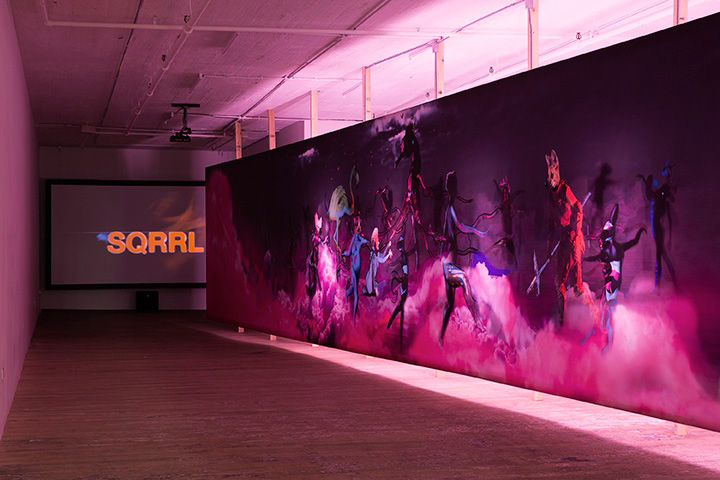Review: John Russell at Bridget Donahue
Frieze #177
March 2016
PDF | Frieze | JR | BD
John Russell has made a video that is both singular and plural. SQRRL/BRUCE WILLIS (2015) grafts a new video on top of an older one: SQRRL (2015), an illustrated story about interspecies brain transplants in the 22nd century, plays over Russell’s Aquarium Proletarium (2014), which animates his essay ‘Bruce Willis, Irigaray, and the Aesthetics of Space Travel’ (2014). Animated GIFs stutter over a scrolling text by the artist that riffs on poststructuralist philosopher Luce Irigaray’s call for a non-binarized model of sexuality and, consequently, multiplicitous writing. The result is messy frottage: dense walls of excursus slide beneath crude animations of viscera, hybridized animals, and Bruce Willis’s shining head, set to an ambient score of wind chimes and whispered narration. All is low-res and choppy. Periodically, a ghostly turtle glides through this ocean of signs, suturing visual information as it goes, anchoring our dive into hallucinatory fiction and bleeding-edge philosophy.
Before viewers meet this turtle they first come across its corpse. It is impaled on a tall, knotted branch, at the mouth of the exhibition, caked in black enamel and resin evoking crude oil. This lonely turtle appears in silhouette, awash in pink fluorescent light. Like a crucifixion scene, it brusquely unites violence, desire, and symbolic transcendence — a trinity scrambled by Russell’s delirious erudition, perhaps against what Irigaray calls “the one of form, of the individual, of the (male) sexual organ, of the proper name, of the proper meaning.”
A long and angular wooden structure bisects the gallery, its back covered with pink fluorescent lightbulbs. It turns the space into a cavernous pink tube, and if the turtle sculpture hangs at the exhibition’s mouth, then its video counterpart drifts around the anus. Russell’s exhibition hinges on the interdependence of brains and bowels, eliding conceptual headiness with scatalogical headlessness. This climaxes on the reverse of the dividing wall, which supports a sprawling, backlit mural printed on vinyl (Mirror Mapping the Stars, 2015), a recurring format for Russell. It depicts a lurid, animistic scene: a coven of nude beast-people dance around a totemic seahorse whose tendrils tether their bodies like a symbiotic Maypole. A flamingo, a skeletal centaur, and a canine warrior interlope. Though the scene is rendered through computer-generated modeling, Russell interrupts that medium’s claims to crisp hyperreality with inky outlines and other painterly intrusions. Here, the digital is anything but a zone of frictionless exchange — symbols carry corporeal and affective weight.
The mural scene’s stark iconography, large scale, and narrative choreography perversely recall the stately populism of Enlightenment history painting. But unlike the legible allegories of classic history paintings, which were familiar to their viewers, Russell’s symbolism is hermetic and evades tidy interpretation. Take the mural’s seahorse: it first reads as a sinister puppeteer, its tendrils phallic probes. However, it is the male seahorse that carries eggs and gives birth, aligning the tendrils with umbilical nourishment. Such slippery conflations abound, recalling Irigaray’s demonstration that actual bodies are more complicated than our schematizations of them.
As with classical allegory, text provides context for Russell’s imagery. The artist’s writings, present throughout SQRRL/BRUCE WILLIS, as well as a parasitic takeover of the gallery’s website, traverse the murky rift between his roles as reader and imagist. Online, SQRRL’s thorough footnotes elaborate his bibliography (Irigaray, Bataille, Brassier, Grosz, Die Hard) and lexicon (‘SQUIRREL,’ ‘TURTLE,’ ‘MEAT’). Rather than parroting theoretical positions, Russell’s texts treat philosophy like fuel for expression. They are generous, and often lucid; even when they are illegibly obscured in the video, one gets the sense that they were meant to actually be read. Yet when accompaenied by bizarre illustrations, the texts’ moments of straight-talk are self-effacing, even comically so. They stage the anxiety of trying to speak Reason while being aware that what speaks is a messy sack of viscera, whose knowledge is inevitably conditioned by sexuality, health, and environment.
This anxious position and Russell’s intellectual voracity are at the heart of the exhibition. The digestion of information yields nourishment as well as its byproducts, and Russell revels in its excesses. Unlike most contemporary art practices deemed ‘cerebral,’ Russell’s orgiastic mode rejects visual sterility without trimming any conceptual meat.
